Translate this page into:
Advanced Aligner Orthodontics
Address for Correspondence: Dr. Ojima Kenji, 2-39-5-2F Hongo Bunko-ku, Tokio, Japan. E-mail: kenjiman2007@yahoo.co.jp
This article was originally published by Wolters Kluwer and was migrated to Scientific Scholar after the change of Publisher.
Abstract
Invisalign initially had limitations which have now been overcome. Advances in the quality of aligner materials, attachments and the introduction of a new force system, have expanded the range of treatment possibilities from severe crowding to more difficult extraction cases, open bite cases, and lower molar distalization cases.
Keywords
AcceleDent
accelerate orthodontics
aligner
aligner orthodontics
craniomandibular dysfunction
extraction orthodontics
Invisalign
midline shift
open bite
orthopulse
temporomandibular disorder
In recent years, adult patients have demanded inconspicuous orthodontic appliances.[1-7] Even with aligner therapy, one of the greatest sources of dissatisfaction among adult patients remains the length of treatment. This article descibes three patients with difficult malocclusions. The first case is a four premolar extraction treatment. The second case is a Class III case treated with lower molar distalization. The last case is a patient with an anterior open bite.
CASE 1: ANTERIOR CROWDING +ACCELEDENT
This 25-year-old female had a chief complaint of anterior crowding and a highly placed canine [Figure 1].[8-11] We planned four premolar extractions and used Invisalign aligner treatment with elastics.
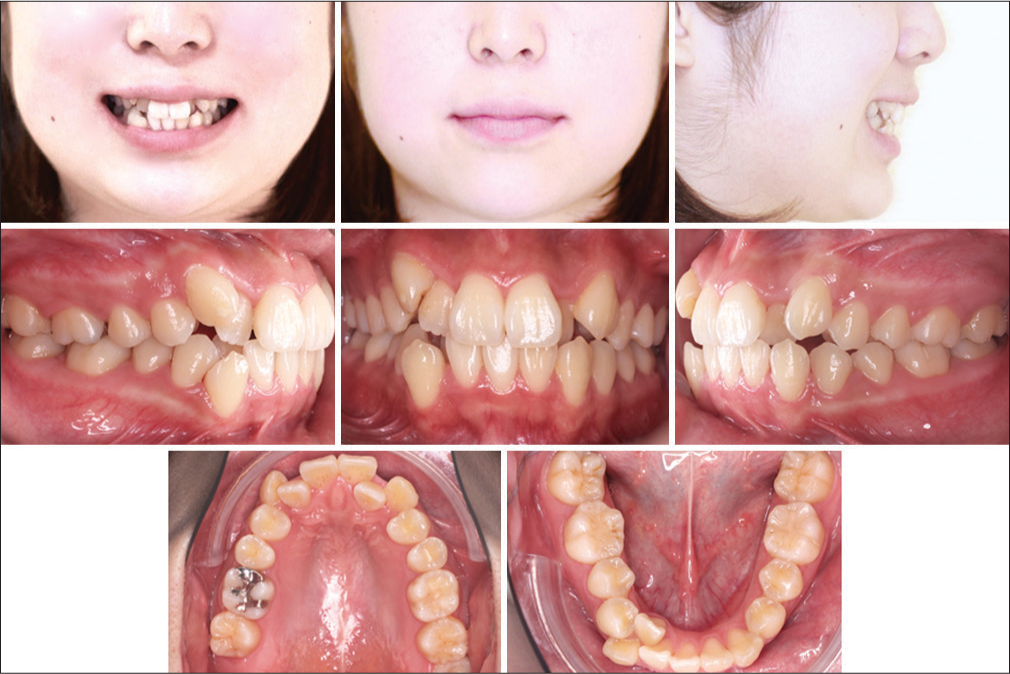
- Initial clinical check
After extraction, we started retraction of canines and leveling of the full arch at the same time [Figures 2-5].

- Initial clinical check
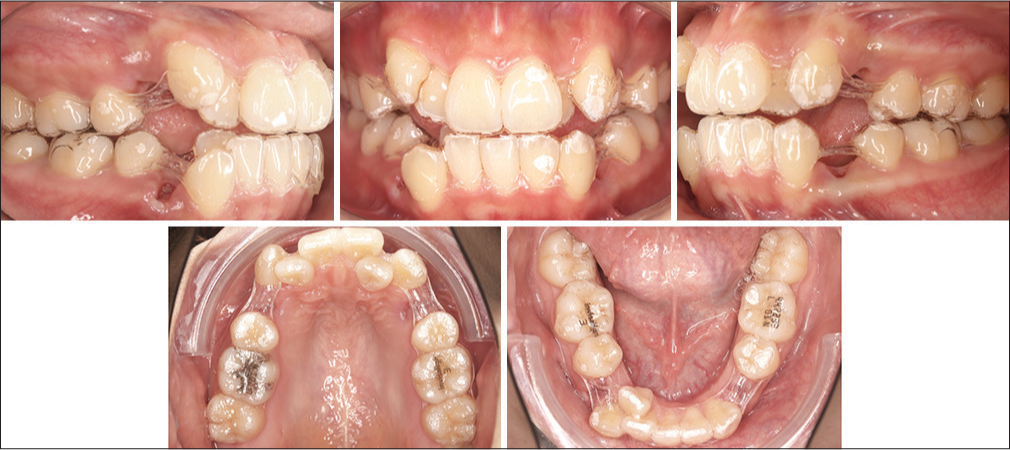
- First aligner set post four premolar extraction

- Case 1 treatment procedure (a) Initial (b) Postextraction (c) Attachment (d) Start retraction (e) Anterior retraction (f) Torque (g) Detail (h) Final
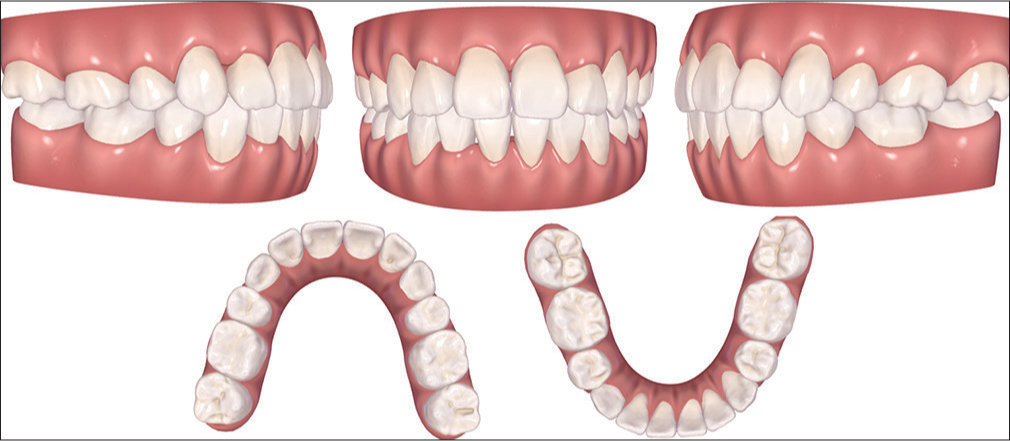
- Final clinical check
This case used an acceleration device AcceleDent[12-18] everyday for 20 min per day at home. Aligners were changed every 5 days
Finally, we obtained space closure and functional guidance.
Treatment time was 18 months for this case [Figure 6].
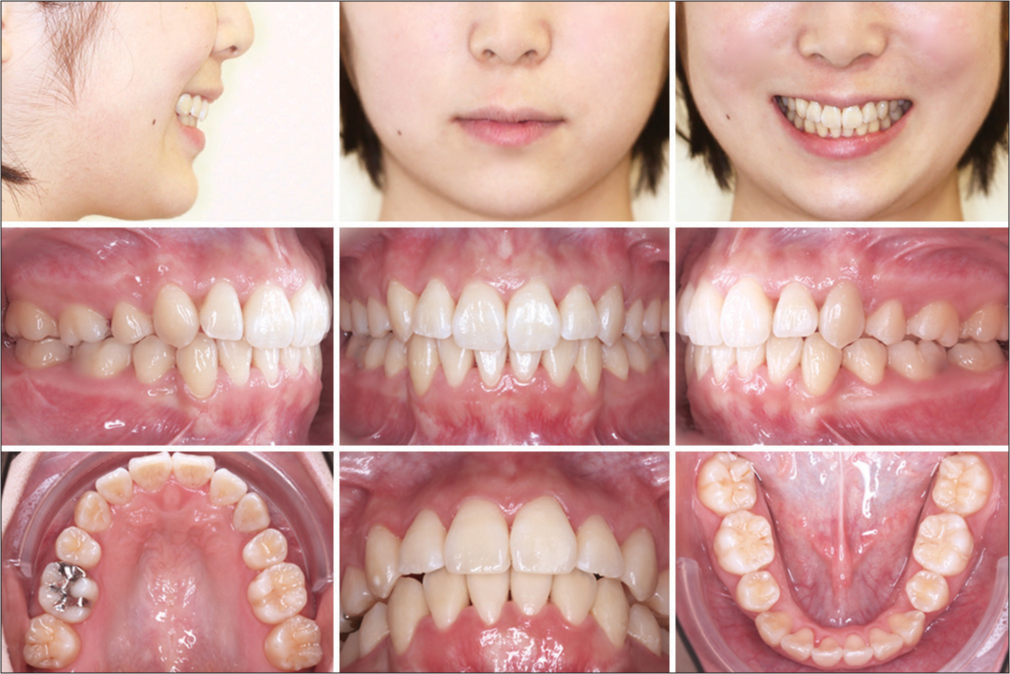
- Final
CASE 2 - INVISALIGN + TEMPORARY ANCHORAGE DEVICES, LOWER MOLAR DISTALIZATION
A 25-year-old male presented with a chief complaint of anterior open bite and Class III[19-21] relationship with a midline shift to right [Figure 7]. We placed temporary anchorage devices in the mandibular arch and used elastics.

- Initial oral
This case used acceleration device AcceleDent everyday for 20 min per day at home. Then, aligners were changed every 5 days. Finally, we improved functional guidance, over bite, overjet, and attained a Class I relationship between canine and molars. Treatment time was 18 months for this case [Figures 7-13].

- Cephalogram and orthopantomogram
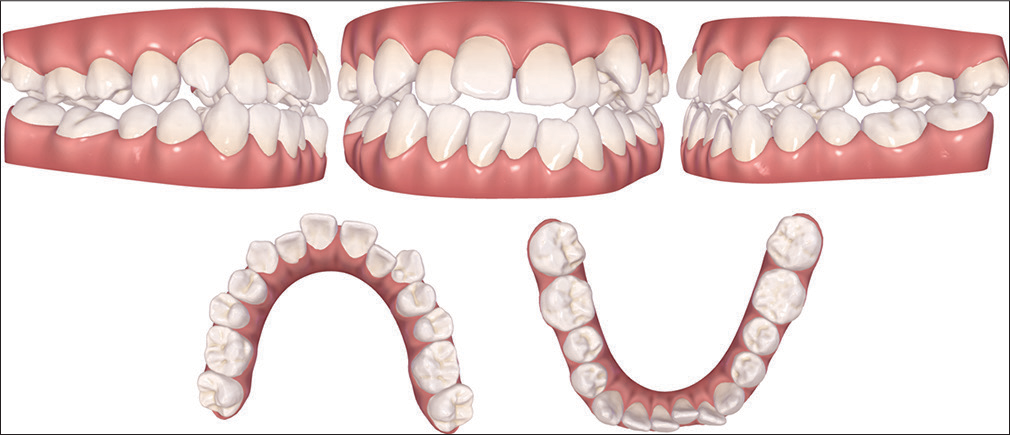
- Initial clinical check
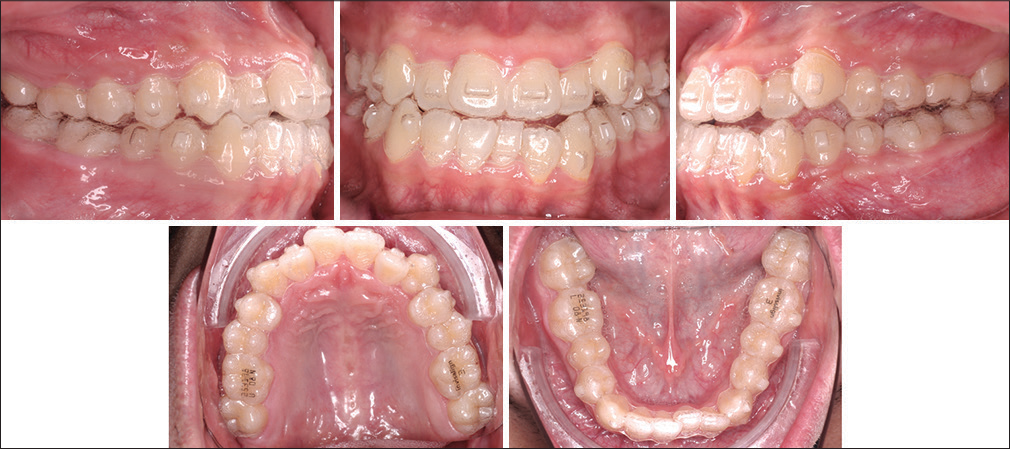
- First aligner set

- Treatment procedure

- Final clinical check

- Cephalogram and orthopantomogram
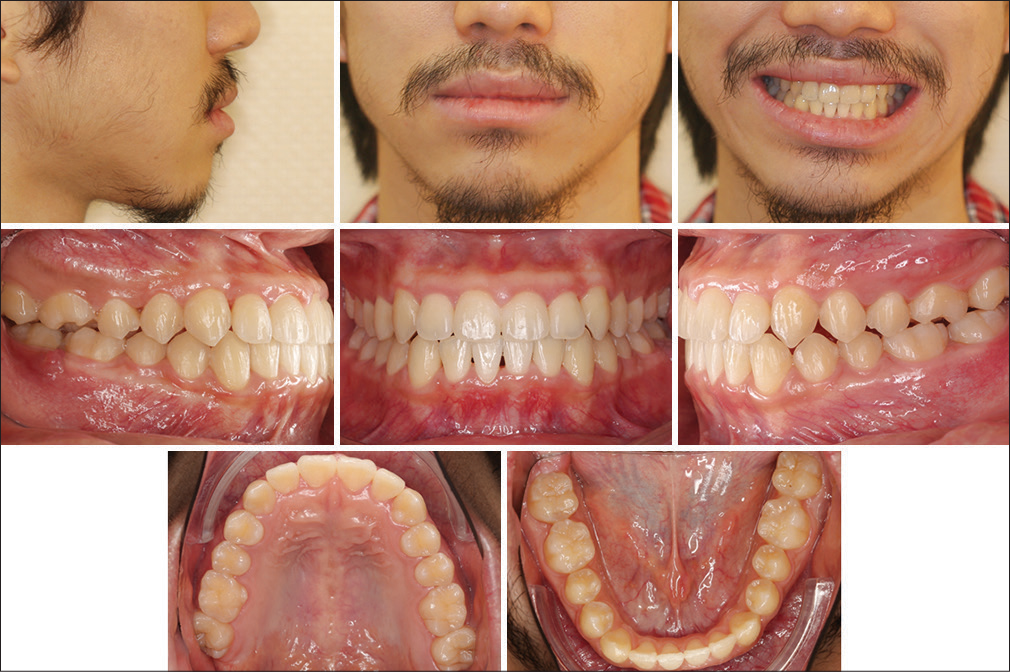
- Final
CASE 3 - OPEN BITE+ACCELERATION
A 40-year-old female presented with a chief complaint of anterior open bite and crowding [Figure 14]. She used Invisalign aligners. Normal Invisalign protocol needed 46 aligners.
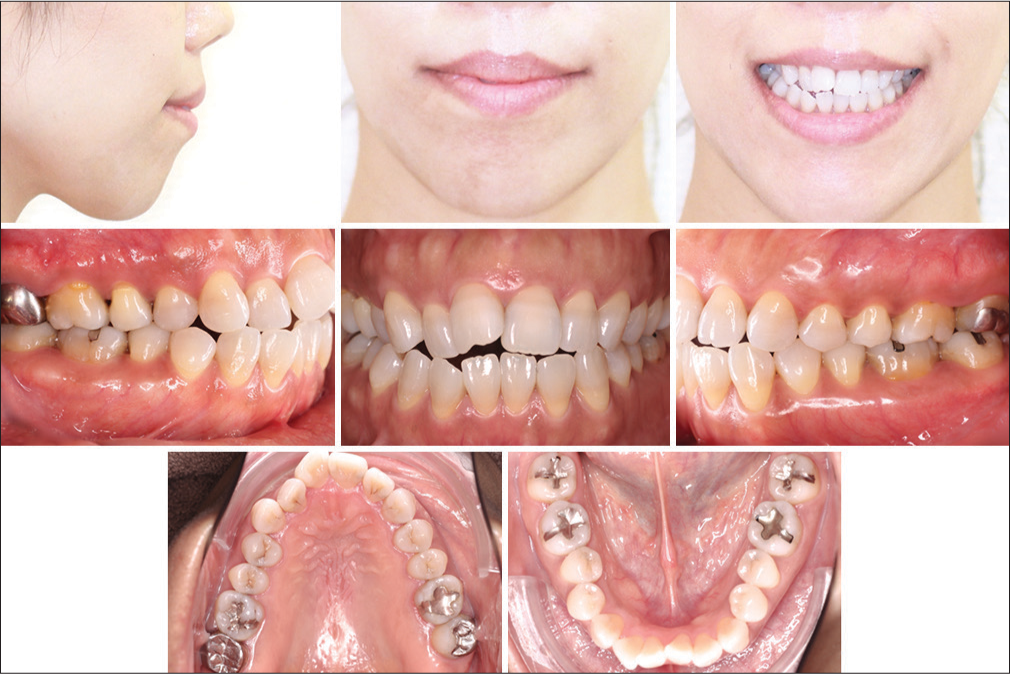
- Initial oral
However we combined Orthopulse,[22] an acceleration device, that allowed the patient to change aligners every 3 days. Orthopulse was used 10 min per day at home. This treatment finished in 6 months (compared to 23 it would have taken with conventional mechanics) [Figures 14-20].

- Aligner set with attachment

- Good Aligner fit during treatment

- Final oral

- Clinical check (a) initial and (b) final

- (a) Initial and (b) final orthopantomogram
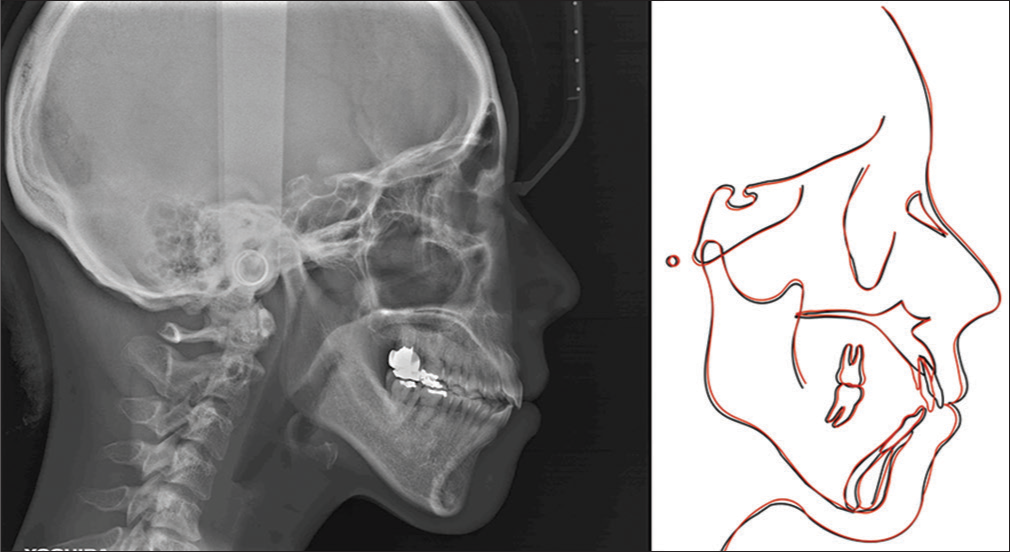
- Initial and final superposition
CONCLUSION
Aligners are not only comfortable and esthetically pleasing to adult patients but, they are easily removed and hygenic. In future, aligners are likely to be used in even more complex cases involving rotations, open bites, and four premolar extractions and lower molar extractions.
Further clinical investigations are needed into the effects of accelerated tooth movement in such cases.
Financial support and sponsorship
Nil.
Conflicts of interest
There are no conflicts of interest.
References
- Orthodontic treatment of a mildly crowded malocclusion using the Invisalign system. Aust Orthod J. 2001;17:41-6.
- [Google Scholar]
- The Invisalign system in adult orthodontics: Mild crowding and space closure cases. J Clin Orthod. 2000;34:203-12.
- [Google Scholar]
- Treatment of severe maxillary crowding using Invisalign and fixed appliances. J Clin Orthod. 2009;43:583-9.
- [Google Scholar]
- Treatment of anterior open bite with the Invisalign system. J Clin Orthod. 2010;44:501-7.
- [Google Scholar]
- Open bite treatment using clear aligners. Angle Orthod. 2013;83:913-9.
- [CrossRef] [PubMed] [Google Scholar]
- Invisalign® treatment in the anterior region: Were the predicted tooth movements achieved? J Orofac Orthop. 2012;73:365-76.
- [CrossRef] [PubMed] [Google Scholar]
- Treatment of collapsed arches using the Invisalign system. J Clin Orthod. 2010;44:416-25.
- [Google Scholar]
- Upper canine extractions in adult cases with unusual malocclusions. J Clin Orthod. 2012;46:102-10.
- [Google Scholar]
- Four-premolar extraction treatment with Invisalign. J Clin Orthod. 2006;40:493-500.
- [CrossRef] [Google Scholar]
- A premolar extraction case using the Invisalign system. J Orofac Orthop. 2006;67:385-94.
- [CrossRef] [PubMed] [Google Scholar]
- A radiographic analysis of tooth morphology following the use of a novel cyclical force device in orthodontics. Head Face Med. 2011;7:14.
- [Google Scholar]
- The clinical evaluation of a novel cyclical force generating device in orthodontics. Orthod Pract. 2010;1:43-4.
- [Google Scholar]
- Periodontal tissue activation by vibration: Intermittent stimulation by resonance vibration accelerates experimental tooth movement in rats. Am J Orthod. 2008;133:572-83.
- [CrossRef] [PubMed] [Google Scholar]
- The effects of a vibrational appliance on tooth movement and patient discomfort: A prospective randomised clinical trial. Aust Orthod J. 2012;28:213-8.
- [Google Scholar]
- Effects of pulsed electromagnetic field vibration on tooth movement induced by magnetic and mechanical forces: A preliminary study. Aust Dent J. 2007;52:282-7.
- [Google Scholar]
- Invisalign treatment of dental class II malocclusions without auxiliaries. J Clin Orthod. 2010;44:665-72.
- [Google Scholar]
- Treatment of challenging malocclusions with Invisalign and miniscrew anchorage. J Clin Orthod. 2014;48:23-36.
- [CrossRef] [Google Scholar]
- Invisalign treatment accelerated by photobiomodulation. J Clin Orthod. 2016;50:309-17.
- [Google Scholar]






